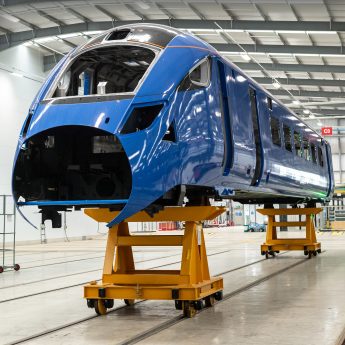Japan’s commitment to the rail industry in North East England reflects its desire to return the favour granted by Britain to the Choshu Five in 1863. That is according to the Japanese speakers at the official opening ceremony of Hitachi Rail’s Newton Aycliffe factory in County Durham on 3 September.
Hailing from modern-day Yamaguchi Prefecture, the pioneering delegation of five young men sailed to the UK against the wishes of the Japanese government’s maritime seclusion policy. They studied at University College London and brought the knowledge and skills they acquired back to Japan, forming the foundations of its modernisation.
The Newton Aycliffe plant is the manufacturing location of new Intercity Express trains for the East Coast Main Line and Great Western Main Line and AT200 EMU trains for the central belt of Scotland.
Hiroaki Nakanishi, chairman and chief executive of Hitachi, Ltd., and Ambassador of Japan to the United Kingdom Keiichi Hayashi said one of the Choshu Five, Masaru Inoue, learned so much from British railways that he pioneered the introduction of similar systems in Japan. He became known as father of the Japanese railway.
Interestingly, the first Hitachi pre-series Class 800 train for the Intercity Express Programme arrived in March at the Port of Southampton—the same port to which the forbearers of this long-lasting connection between the two countries arrived, albeit under very different circumstances.
Hitachi Rail Europe is one of few Japanese firms to base their global headquarters in the UK. In doing so, they are showing a commitment to the UK that has been recognised and warmly welcomed.
Addressing the audience at the event, Alistair Dormer, global chief executive of Hitachi Rail, First Secretary of State George Osbourne, and Prime Minister David Cameron said the inward investment from Hitachi Rail Europe provides a massive boost for the regional economy and British manufacturing.
They said train building was returning home, given the historical connection of the North East to the industry. Indeed, the factory is mere metres away from Heighington Station, where George Stephenson’s Locomotion No.1—the first steam locomotive to carry passengers on a public rail line—was assembled and put on the tracks in 1825.
Speakers added that Hitachi Rail’s operations in the UK combine Japanese technology and British manufacturing. Many British engineers employed at Newton Aycliffe have made trips or will make fact-finding trips to Hitachi’s Kasado factory in Yamaguchi Prefecture.






